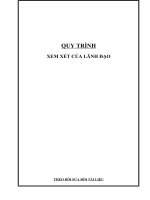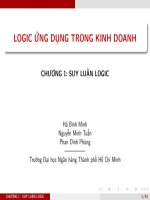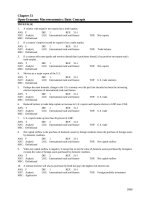Chapter 03 deadlock
Bạn đang xem bản rút gọn của tài liệu. Xem và tải ngay bản đầy đủ của tài liệu tại đây (764.28 KB, 35 trang )
Chapter 3
Deadlocks
3.1. Resource
3.2. Introduction to deadlocks
3.3. The ostrich algorithm
3.4. Deadlock detection and recovery
3.5. Deadlock avoidance
3.6. Deadlock prevention
3.7. Other issues
1
Chapter Objectives
•
To develop a description of deadlocks, which prevent sets of
concurrent processes from completing their tasks
•
To present a number of different methods for preventing or
avoiding deadlocks in a computer system.
2
Resources(1)
•
Examples of computer resources
–
–
–
•
•
printers
tape drives
tables
Processes need access to resources in reasonable order
Suppose a process holds resource X and requests resourceY
–
–
at same time another process holds Y and requests X
both are blocked and remain so
3
Resources (2)
•
Deadlocks occur when …
– processes are granted exclusive access to devices
– we refer to these devices generally as resources
•
Preemptable resources
– can be taken away from a process with no ill effects
•
Nonpreemptable resources
– will cause the process to fail if taken away
4
Resources (3)
•
Sequence of events required to use a resource
1.
2.
3.
•
request the resource
use the resource
release the resource
Must wait if request is denied
–.
–.
requesting process may be blocked
may fail with error code
5
Resources (4)
•
Example request/release as system call
– request/release device
– open/close file
– allocate/free memory
– wait/signal
6
Introduction to Deadlocks
•
Formal definition :
A set of processes is deadlocked if each process in the set is waiting for an event that only another process in
the set can cause
•
•
Usually the event is release of a currently held resource
None of the processes can …
–
–
–
run
release resources
be awakened
7
Four Conditions for Deadlock
Mutual exclusion condition
1.
•
each resource assigned to 1 process or is available
Hold and wait condition
2.
•
process holding resources can request additional
No preemption condition
3.
•
previously granted resources cannot forcibly taken away
Circular wait condition
4.
•
•
must be a circular chain of 2 or more processes
each is waiting for resource held by next member of the chain
8
Deadlock Modeling (1)
•
•
Modeled with directed graphs
Resource-Allocation Graph (RAG)
–
–
–
resource R assigned to process A
process B is requesting/waiting for resource S
process C and D are in deadlock over resources T and U
9
Deadlock Modeling (2)
A
B
C
How deadlock occurs
10
Deadlock Modeling (3)
(o)
(p)
(q)
How deadlock can be avoided
11
Strategies for dealing with Deadlocks
1.
just ignore the problem altogether
2.
detection and recovery
3.
dynamic avoidance
•
4.
careful resource allocation
prevention
•
negating one of the four necessary conditions
12
The Ostrich Algorithm
•
•
Pretend there is no problem
Reasonable if
– deadlocks occur very rarely
– cost of prevention is high
•
•
UNIX and Windows takes this approach
It is a trade off between
– convenience
– correctness
13
Detection with Multiple Resource of Each Type (1)
Data structures needed by deadlock detection algorithm
14
Detection with Multiple Resource of Each Type (2)
The deadlock detection algorithm:
1.
Look for unmarked process, Pi, for which the
i-th row of R is less than or equal to A
2.
If such process is found, add the i-th row of C to A , mark the process and go back
to step 1
3.
If no such process exists, the algorithm terminates.
When algorithm terminates, any unmarked processes
are known to be dealocked
15
Detection with Multiple Resource of Each Type (3)
An example for the deadlock detection algorithm
After first cycle A=(2 2 2 0),
After second cycle A=(4 2 2 1)
16
Recovery from Deadlock (1)
•
Recovery through preemption
– take a resource from some other process
– depends on nature of the resource
•
Recovery through rollback
– checkpoint a process periodically
– use this saved state
– restart the process if it is found deadlocked
17
Recovery from Deadlock (2)
•
Recovery through killing processes
– crudest but simplest way to break a deadlock
– kill one of the processes in the deadlock cycle
– the other processes get its resources
– choose process that can be rerun from the beginning
18
Deadlock Avoidance
Resource Trajectories
Two process resource trajectories
19
Deadlock Avoidance
Basic Facts
•
At any instant of time, current state of system consisting of E (Resources in
Existance), A (Resource Available), C (Current allocation matrix), R (Request
matrix)
•
•
•
If a system is in safe state ⇒ no deadlocks.
If a system is in unsafe state ⇒ possibility of deadlock.
Avoidance ⇒ ensure that a system will never enter an unsafe state.
20
Deadlock Avoidance
Safe, Unsafe , Deadlock State
21
Deadlock Avoidance
Safe and Unsafe States (1)
(a)
(b)
(c)
(d)
(e)
- Example: 3 processses A, B, C using one resource with total 10 instances, 7
already allocated, 3 available
- Demonstration that the state in (a) is safe
22
Deadlock Avoidance
Safe and Unsafe States (2)
(a)
(b)
(c)
(d)
Demonstration that the state in b is not safe
23
Deadlock Avoidance
The Banker's Algorithm for a Single Resource (1)
(a)
(b)
•
(c)
Three resource allocation states
–
–
–
(a) safe
(b) safe
(c) unsafe
24
Deadlock Avoidance
The Banker's Algorithm for a Single Resource (2)
•
•
•
•
The banker’s algorithm considers each request as it occurs, and see if granting it leads to a safe state.
If it does, the request is granted; otherwise, it is postponed until later.
To see if a state is safe, the banker checks to see if he has enough resources to satisfy some customer.
If so, those loans are assumed to be repaid, and the customer now closest to the limit is checked, and
so on. If all loans can eventually be repaid, the state is safe and the initial request can be granted.
25









